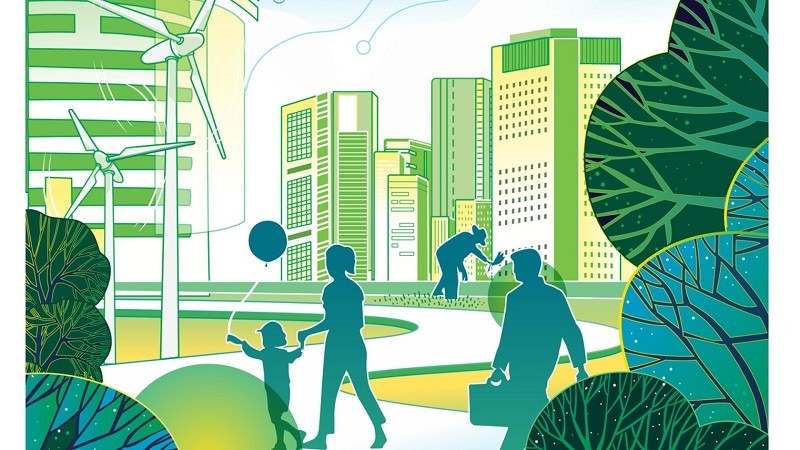
Building a green economy and takeaways for Vietnam
Latest
Building a green economy is becoming a development trend in the world, since countries are pursuing the goal of both promoting economic growth, and solving the challenges of environmental pollution and climate change.
 |
| Building a green economy is becoming a trend in the world. (Photo: UNDP) |
A green economy is defined by the United Nations Environment Programme (UNEP) as achieving the goals of low carbon, resource efficiency and social integration.
According to the European Environment Agency (EEA), the goal of a green economy is to meet human needs for food, transport, energy... in a fair and sustainable manner. The International Chamber of Commerce (ICC) defines a green economy as economic growth and environmental responsibility that go hand in hand, reinforce each other, and support social development.
In general, the definitions of a green economy emphasize the importance of integrating economic policies with the environment, with the aim to minimize the negative impact of economic activities on the environment. Green economic policies involve many different fields, from energy, finance, agriculture, investment, manufacturing, tourism, transportation, etc.
Vietnam is not excluded from the global trend of green economic development, especially when it is one of the countries that is heavily affected by climate change. The country has and has had many opportunities for greening the economy. However, while many aspects have been effectively promoted and certain achievements have been achieved, the potential is still great and many challenges still remain.
In the coming period, with the policy of proactively integrating into the international and regional economy, experiences from other countries are considered useful lessons for Vietnam in order to keep up with the trend of greening the economy.
Some examples include the United States, with policies that encourage low-carbon industries or promote energy management in buildings; the European Union, with the "Clean Energy for all Europeans” package (CEP) adopted in 2019 to encourage EU members to gradually transition to a low-emission economy; or Singapore, also known as the World’s Greenest City.
Singapore: Role model in Southeast Asia
Singapore is considered as a role model in green economic development in response to climate change in Asia. As a city with a lack of resources, the “Lion City” has a strong sense of sustainable development and emission reduction.
The Singaporean Government first launched the Green Plan in 1992, then followed it up with the Singapore Green Plan 2012. In February 2021, the Government continued to announce the Singapore Green Plan 2030, a “global movement” with the aim of advancing the national agenda for sustainable development and achieving net zero emissions “as soon as possible.”
Some of the new initiatives in this plan include that by 2030 all newly registered cars must be green vehicles, and the number of electric vehicle charging stations must be more than doubled.
Singapore has increased its solar capacity more than sevenfold since 2015 and has one of the highest solar densities in the world. In July 2021, Singapore put into operation one of the largest floating solar farms in the world, including 120,000 solar panels at Lake Tengeh with a maximum capacity of 60 MW.
Singapore has been taking many steps to create a green economy, from energy transition to universalization of green vehicles, and building green living models across the city.
Lessons for Vietnam
At the COP 26 Climate Conference, Vietnam committed to net zero emissions by 2050, along with raising the rate of renewable energy to over 30% of total primary energy supply and forest cover of 43%.
In reality, Vietnam can go further and achieve more than it has set, as 70% of the country's emissions come from the energy industry, most of which comes from the electricity generation industry. Therefore, if Vietnam can accelerate the transition from coal to wind and solar power, it will help contribute to the greening of the economy.
Vietnam must develop and constantly improve the provisions of the law on the green economy, as well as establish supportive policies for green economic sectors, such as tax reductions, capital incentives, promotion of research and improvement of technology, and favourable conditions for the exchange of experiences between domestic and foreign businesses…
These supportive policies will help improve the competitiveness of "green" goods and services, motivating businesses to transition to green economic models.
Along with Vietnam’s own resources, the country needs to mobilize resources from international partners. Vietnam must continue to implement policies to attract capital flows and investment projects that meet environmental standards as well as technology transfer in the field of green economy.
Furthermore, not only should Vietnam encourage investment in renewable energy, it must focus on transformation in all areas of the economy, from green agriculture, green tourism or implementing projects with friendly and high-tech applications.
Experiences from other countries show that there are many approaches to a green economy, which generally require coordination at all levels from central to local management agencies, businesses and people, and the commitments made must be practical and specific.

















